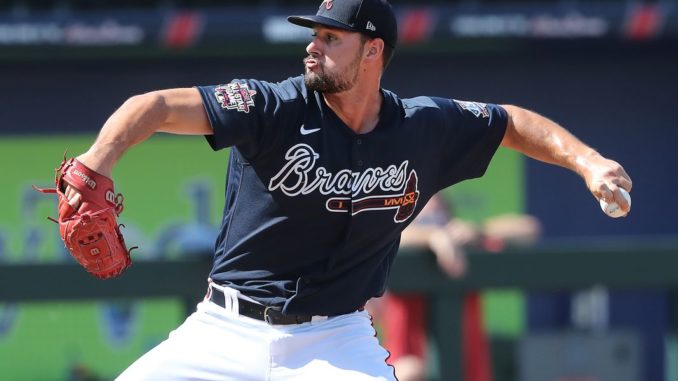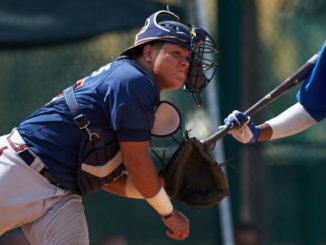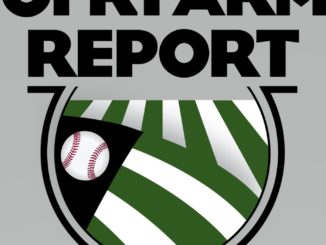
Happy March, Braves fans. Only two days until actual, for-real baseball is ready to be played, and only a little over a month before affiliated minor league baseball resumes after an 18-month layover.
This is the fifth composite prospect list I’ve put together. Here is last year’s by way of comparison.
To make this list, I simply average the rankings across different prospect lists, then penalize each player one point (adding to their score) for each list that they were not included. That means that Shea Langeliers, included on all 12 lists with an average ranking of 4.92, scored a 4.91. Catcher Logan Brown showing up on 5 lists with an average rating of 29.83 scores a 35.83. Ties are broken by giving the edge to whichever prospect finished higher on a list.
Only prospects that have appeared on at least five of the twelve lists are included. The most significant prospect excluded because of this is infielder Ambioris Tavarez, who was just signed as an amateur international free agent in January, after most of the lists included on this were finalized.
There was also some disagreement on how to treat right-handers Bryse Wilson and Huascar Ynoa. Under traditional rules of determining who is or isn’t a prospect, neither Wilson nor Ynoa has pitched enough innings or accrued enough service time to graduate off the prospect lists. However due to the unusual pandemic-related circumstances, MLB announced that being on a roster in September, time typically excluded for purposes of determining rookie eligibility, would be included for consideration. Counting September service time both Wilson and Ynoa exceeded the rookie eligibility ceiling.
Of course anyone making their own list are free to include or exclude anyone they wish. Because some included and some excluded, for the purpose of this composite I have removed Wilson and Ynoa where they appeared and bumped everyone else up by one on those lists.
For this composite ranking, I chose 12 prospect lists that covered a variety of sources and expertise.
- The Athletic (Keith Law)
- Atlanta Braves Prospects (David Lee)
- Baseball America (Carlos Collazo)
- Baseball Prospectus (Jeffrey Paternostro, Kris Willis, and BP Prospect Staff)
- ESPN (Kiley McDaniel)
- Fangraphs (Eric Longenhagen and Kevin Goldstein)
- MLB Pipeline (Jonathan Mayo)
- Outfield Fly Rule (Andy Harris and Matt Chrietzberg)
- Prospects 1500 (Jake Berry)
- Prospects Live (Ralph Lifshitz, Matt Thompson, Eddy Almaguer)
- Talking Chop (Eric Cole, Garrett Spain, Wayne Cavadi, Gaurav Vedak, and Matt Powers)
- Video Baseball Scout (Ben Chase)
Each of the folks who put these lists together have given this a lot of thought, and all of their write-ups are worth reviewing. I have separated the list into tiers based on their scoring strata.
Tier One
1. Cristian Pache, OF – 1.33
2. Ian Anderson, RHP – 1.83
Pache retains his top prospect ranking, though it’s consensus not unanimous as it was in 2020. This likely has less to do with any change on Pache’s part and more on the fantastic major league debut of Ian Anderson, who once again finishes as the number two prospect in the system, but nipping right on Pache’s heels. With both players projected to start the 2021 season in the major leagues, neither are likely to remain prospects for much longer and both are National League Rookie of the Year candidates.
Tier Two
3. Drew Waters, OF — 3.25
4. Shea Langeliers, C — 4.92
5. William Contreras, C — 5.67
6. Braden Shewmake, SS — 6.83
7. Kyle Muller, LHP — 7.08
8. Tucker Davidson, LHP — 8.33
9. Jared Shuster, LHP — 8.42
10. Michael Harris, OF — 9.83
11. Jasseel De La Cruz, RHP — 11.91
While the exact order varied quite a bit, there was broad consensus on who made up the rest of the top 10 after Pache and Anderson.
Drew Waters was chosen as the #3 prospect on seven of the lists and #2 on two more. Last year catchers Langeliers and Contreras finished in an exact tie, but Langeliers takes the lead in 2021 with most of the national writers preferring Langeliers and the local writers (David Lee, OFR, the Talking Chop gang) preferring Contreras.
Jared Shuster is the first of the 2020 draftees to make the list as reports from him work at the Alternate Training Site in 2020 were strong.
Spring sensation Michael Harris rounds out the top 10, and he represented the final prospect to show on all 12 lists. Perhaps not surprisingly, Harris showed the most improved score over any prospect that was also included on last season’s list.
Tier Three
12. Victor Vodnik, RHP — 16.91
13. Patrick Weigel, RHP — 16.60
14. Bryce Ball, 1B — 16.67
15. Freddy Tarnok, RHP — 18.00
16. Vaughn Grissom, SS — 19.09
17. Trey Harris, OF — 20.00
18. Alex Jackson, C — 20.38
19. Jesse Franklin, OF — 21.40
20. Bryce Elder, RHP — 21.78
Again, a lot of consensus on which prospects make up the rest of the top 20, though the order varied quite a bit. Bryce Ball seems to be the most likely of this group to break into the top 10, and made it that high in two lists already.
The shine seems to be coming off Patrick Weigel with his future seemingly more solidly in the relief pitcher likelihood and his 27th birthday coming in July.
Vaughn Grissom is the next member of the 2019 prep class drafted by Atlanta, following Michael Harris.
Bryce Elder and Jesse Franklin debut on the list from the 2020 draft. Alex Jackson had some of the highest variance on the list as evaluators wrestle both his raw power and a hit tool that has been stubbornly poor.
Tier Four
21. Spencer Strider, RHP — 26.00
22. Tyler Owens, RHP — 26.78
23. Daysbel Hernandez, RHP — 27.14
24. Greyson Jenista, OF — 29.14
25. Mahki Backstrom, 1B — 29.17
25. William Woods, RHP — 30.86
Three members of this grouping — Hernandez, Woods, and 2020 draftee Strider — have big fastballs and likely relief pitcher profiles. Owens and Backstrom are more members of the 2019 prep draftees.
Woods represents one of the few prospects to make a big climb, not appearing on any list last season to making the top 25 a year later despite no minor league games played.
Going in the opposite direction is Greyson Jenista, who really missed out on 2020 development following a 2019 that saw him attempt a swing change.
Tier Five
28. Justin Dean, OF — 30.98
29. Stephen Paolini, OF — 31.00
30. Kasey Kalich, RHP — 31.02
31. CJ Alexander, 3B — 31.14
31. Ricky DeVito, RHP — 35.29
32. Thomas Burrows, LHP — 35.67
33. Logan Brown, C — 35.83
34. Beau Philip, SS — 48.25
The final tier is an eclectic group of prospects that are alike only in that each have interesting tools and skills but also have some sort of negative that keep them from being more highly considered at this time.
Reliever Kasey Kalich is coming off an off-season injury that prevented him from getting significant development in 2020. If healthy, he may have been a candidate for the Alternate Training Site or certainly the instructional league. Similarly third baseman CJ Alexander was coming off an injury-plagued 2019 season that put a significant damper on the buzz that followed him after performing well following the 2018 draft.
Justin Dean has strong speed and defensive tools that made him a force in low-A in 2019. It remains to be seen if he will hit enough to be able to continue his progress at higher levels.
Stephen Paolini is another member of the 2019 draft class taken from high schools. He has essentially every tool, but is raw and missing development time in 2020 was certainly not good timing for him.
Ricky DeVito is someone often looked at as a sleeper in the system, with a relatively advanced repertoire and who is young enough not to have been significantly effected by the lost 2020 season. What he doesn’t have is much pro experience or pedigree.
Thomas Burrows has had a long minor league gestation period, but got significant looks in the major league spring camp and could be a promotion candidate during the season. His first exposure to AAA in 2019 didn’t go well, but many pitchers struggled at that level due to the hyper-active ball.
Logan Brown doesn’t do any one thing great but does a lot of things well. He could find himself as a major league back-up or as an organizational catcher. Beau Philip showed better-than-expected defensive abilities in his pro debut in 2019 but needs to show he can hit well enough to be a major league utility player.




Leave a Reply